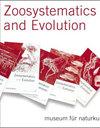A new deep-sea species of Elliptiolucina Cosel & Bouchet, 2008 (Bivalvia, Lucinida, Lucinidae) from cold seep of the South China Sea
IF 0.9
2区 生物学
Q2 ZOOLOGY
引用次数: 0
Abstract
The increasing discoveries of new species of the family Lucinidae in the last two decades indicated a surprising diversity of chemosynthetic lucinids in the deep sea, especially in the Indo-West Pacific. However, only a few records have been reported from the South China Sea. A new lucinid species Elliptiolucina subovalissp. nov. is here reported from a deep-sea cold seep site of the South China Sea. The new species is distinct from its congeners by possessing a strong anterior lateral tooth on the right valve and anterior tapering, subrectangular-oval shells. Sequences of three genes (18S rRNA, 28S rRNA, and CytB) were used to analyze its relationships with other species in the subfamily Myrteinae and confirm its taxonomic placement. The result supports the monophyly of Myrteinae but also demonstrates the polyphyly of Elliptiolucina. The new species has a close relationship with E. williamsae and Rostrilucina garuda, but is not closely related to congener E. ingens. By comparing morphological characters, we suggest that E. ingens should not belong to the genus Elliptiolucina. The basal two of three deep-sea clades recognized in Myrteinae may indicate the deep-sea origin of this subfamily. Our results add to the known diversity of deep-sea lucinids and molecular information for poorly studied Myrteinae and highlight the necessity of further investigation on deep-sea lucinids of the South China Sea.A深海Elliptiolucina Cosel & Bouchet, 2008(双壳亚目,Lucinida, Lucinidae)来自南海冷泉的新种
在过去的二十年里,越来越多的Lucinidae科新种的发现表明,在深海,特别是在印度-西太平洋,化学合成的lucinidids具有惊人的多样性。然而,在南中国海只有少数记录被报道。标题一新种——黄花光属。11月11日的报道来自中国南海的一个深海冷渗点。这个新物种与它的同类不同,它在右瓣上有一个强壮的前侧齿和前渐细的、近矩形椭圆形的壳。利用18S rRNA、28S rRNA和CytB三个基因序列分析其与桃金娘亚科其他种的亲缘关系,确定其分类位置。结果支持桃金娘科的单系性,同时也证实了椭圆桃金娘科的多系性。该新种与黄花蓟马和黄花蓟马亲缘关系较近,但与同系种黄花蓟马亲缘关系不密切。通过形态特征的比较,我们认为银芽草不属于椭圆藻属。在桃金娘亚科中发现的3个深海分支中的2个可能表明该亚科起源于深海。本研究结果增加了深海lucinids的已知多样性和对桃金娘亚科研究不足的分子信息,并强调了进一步研究南海深海lucinids的必要性。
本文章由计算机程序翻译,如有差异,请以英文原文为准。
求助全文
约1分钟内获得全文
求助全文
来源期刊

Zoosystematics and Evolution
ZOOLOGY-
CiteScore
3.50
自引率
5.00%
发文量
34
审稿时长
16 weeks
期刊介绍:
Zoosystematics and Evolution, formerly Mitteilungen aus dem Museum für Naturkunde in Berlin, is an international, open access, peer-reviewed life science journal devoted to whole-organism biology. It publishes original research and review articles in the field of Metazoan taxonomy, biosystematics, evolution, morphology, development and biogeography at all taxonomic levels. The journal''s scope encompasses primary information from collection-related research, taxonomic descriptions and discoveries, revisions, annotated type catalogues, aspects of the history of science, and contributions on new methods and principles of systematics. Articles whose main topic is ecology, functional anatomy, physiology, or ethology are only acceptable when of systematic or evolutionary relevance and perspective.
 求助内容:
求助内容: 应助结果提醒方式:
应助结果提醒方式:


